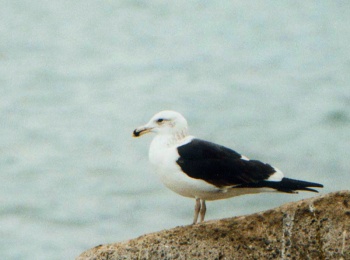KCFoggin-243 (talk | contribs) |
(Picture of adult. Basic update. References updated.) |
||
| Line 1: | Line 1: | ||
| + | [[File:BF Olrog's Gull,RS.jpg|thumb|550px|right|Photo © by {{user|renato.santos.4b|Renato Santos}} <br />Mar del Plata, Buenos Aires, [[Argentina]], 4 June 2021]] | ||
| + | ;[[:Category:Larus|Larus]] atlanticus | ||
| − | |||
| − | |||
==Identification== | ==Identification== | ||
| − | Length 50-56 cm, wingspan 130-140 cm, weight 900-960 g<br /> | + | [[Image:Olrogs_Gull.jpg|thumb|350px|right|Subadult<br />Photo © by {{user|Fritz73|Fritz73}}<br />Mar del Plata, Buenos Aires, [[Argentina]] ]] |
| + | Length 50-56 cm (19¾-22 in), wingspan 130-140 cm, weight 900-960 g<br /> | ||
*Adult: white head, neck, rump and underside, black wings with broad white trailing edge, black band on tail, bright yellow legs, yellow bill with a black band near the end, and red tip. Head smudged grey-brown in winter. | *Adult: white head, neck, rump and underside, black wings with broad white trailing edge, black band on tail, bright yellow legs, yellow bill with a black band near the end, and red tip. Head smudged grey-brown in winter. | ||
*Subadult: much as adult, but varying amount of brown retained on wings, no red tip on bill, and legs pinkish-yellow. | *Subadult: much as adult, but varying amount of brown retained on wings, no red tip on bill, and legs pinkish-yellow. | ||
| Line 13: | Line 14: | ||
==Taxonomy== | ==Taxonomy== | ||
| − | + | This is a [[Dictionary_M-S#M|monotypic]] species<sup>[[#References|[3]]]</sup>. Closely related to [[Belcher's Gull]] from the Pacific coast of South America, and first described as a subspecies of it though now universally treated as a separate species<sup>[[#References|2]]</sup>. | |
==Habitat== | ==Habitat== | ||
Flat, sandy islands, beaches, rocky coasts, harbours, coastal and brackish lagoons and estuaries. | Flat, sandy islands, beaches, rocky coasts, harbours, coastal and brackish lagoons and estuaries. | ||
| Line 19: | Line 20: | ||
Total population small, only around 7,000 pairs, now stable with better protection after a historical decline. Upgraded from Vulnerable to '''Near Threatened''' in the IUCN Red List.<sup>[[#References|1]]</sup> | Total population small, only around 7,000 pairs, now stable with better protection after a historical decline. Upgraded from Vulnerable to '''Near Threatened''' in the IUCN Red List.<sup>[[#References|1]]</sup> | ||
==Behaviour== | ==Behaviour== | ||
| + | ====Breeding==== | ||
Eggs are laid in September-October and chicks fledge in November. | Eggs are laid in September-October and chicks fledge in November. | ||
| − | + | ====Diet==== | |
The diet includes mainly of crabs in the breeding season, taken on tidal mudflats; also takes some shellfish and small fish. Unlike [[Belcher's Gull]] and [[Kelp Gull]], does not normally scavenge for carrion or take seabirds<sup>[[#References|2]]</sup>. | The diet includes mainly of crabs in the breeding season, taken on tidal mudflats; also takes some shellfish and small fish. Unlike [[Belcher's Gull]] and [[Kelp Gull]], does not normally scavenge for carrion or take seabirds<sup>[[#References|2]]</sup>. | ||
==References== | ==References== | ||
# BirdLife International Species factsheet: ''Larus atlanticus''. Downloaded from [http://www.birdlife.org/datazone/search/species_search.html?action=SpcHTMDetails.asp&sid=3210&m=0 http://www.birdlife.org] on 12/12/2014. | # BirdLife International Species factsheet: ''Larus atlanticus''. Downloaded from [http://www.birdlife.org/datazone/search/species_search.html?action=SpcHTMDetails.asp&sid=3210&m=0 http://www.birdlife.org] on 12/12/2014. | ||
| − | #{{Ref-HBWVol3}} | + | #{{Ref-HBWVol3}}#{{Ref-Clements6thAug19}} |
{{ref}} | {{ref}} | ||
==External Links== | ==External Links== | ||
Revision as of 21:29, 20 June 2021
- Larus atlanticus
Identification
Length 50-56 cm (19¾-22 in), wingspan 130-140 cm, weight 900-960 g
- Adult: white head, neck, rump and underside, black wings with broad white trailing edge, black band on tail, bright yellow legs, yellow bill with a black band near the end, and red tip. Head smudged grey-brown in winter.
- Subadult: much as adult, but varying amount of brown retained on wings, no red tip on bill, and legs pinkish-yellow.
- Juvenile: mostly brown overall, with black tail and whiter face and undertail; bill dull yellow with black tip; legs pinkish-yellow.
Similar species
Averages smaller than Kelp Gull, though largest Olrog's just overlap with smallest Kelp, and has black band on tail at all ages. Very similar to Belcher's Gull but does not overlap in range; differs in sharply demarcated edge of white to black on the nape and back (graded grey tones in Belcher's).
Distribution
Breeds on the Atlantic Ocean coast of Argentina, from 38°S to 45°S. Nonbreeding (winter) range includes the coast north to Uruguay and southernmost Brazil.1
Taxonomy
This is a monotypic species[3]. Closely related to Belcher's Gull from the Pacific coast of South America, and first described as a subspecies of it though now universally treated as a separate species2.
Habitat
Flat, sandy islands, beaches, rocky coasts, harbours, coastal and brackish lagoons and estuaries.
Status
Total population small, only around 7,000 pairs, now stable with better protection after a historical decline. Upgraded from Vulnerable to Near Threatened in the IUCN Red List.1
Behaviour
Breeding
Eggs are laid in September-October and chicks fledge in November.
Diet
The diet includes mainly of crabs in the breeding season, taken on tidal mudflats; also takes some shellfish and small fish. Unlike Belcher's Gull and Kelp Gull, does not normally scavenge for carrion or take seabirds2.
References
- BirdLife International Species factsheet: Larus atlanticus. Downloaded from http://www.birdlife.org on 12/12/2014.
- Del Hoyo, J, A Elliot, and J Sargatal, eds. 1996. Handbook of the Birds of the World. Volume 3: Hoatzin to Auks. Barcelona: Lynx Edicions. ISBN 978-8487334207
- Clements, J. F., T. S. Schulenberg, M. J. Iliff, S. M. Billerman, T. A. Fredericks, B. L. Sullivan, and C. L. Wood. 2019. The eBird/Clements Checklist of Birds of the World: v2019. Downloaded from http://www.birds.cornell.edu/clementschecklist/download/
Recommended Citation
- BirdForum Opus contributors. (2024) Olrog's Gull. In: BirdForum, the forum for wild birds and birding. Retrieved 6 May 2024 from https://www.birdforum.net/opus/Olrog%27s_Gull





